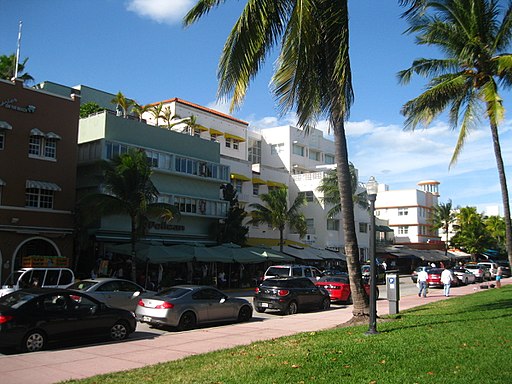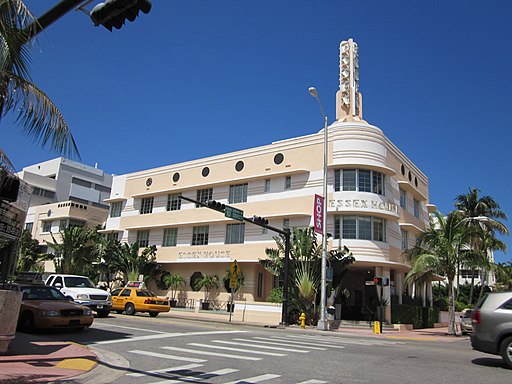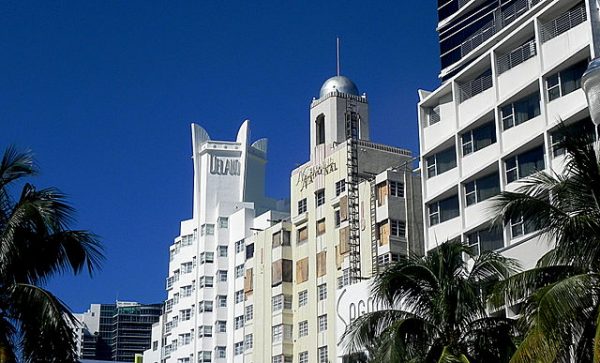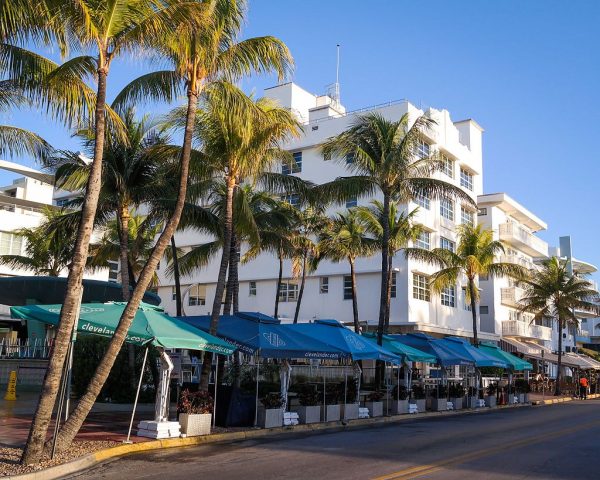24 SW 4th St
Miami, FL 33130
90 SW 3rd St
Miami, FL 33130

Miami Deco District
Developer Glenn Curtis sought to reproduce the Arabian Nights in Opa-Locka.
George Merrick’s Coral Gables appears transplanted from the Mediterranean Coast.
And industrialist Henry Flagler bounced promiscuously from Colonial to Georgian to Neo-Classical.
As wealthy pioneer land barons sought to import ornate looks from other times and time zones, pre-Depression Miami architecture became characterized by its pastiche of styles.
But after the land bubble burst in 1925, and the Depression further battered fortunes in 1929, opulence was out and prudence was in.
An economical and thoroughly modern architectural style would reign over Miami’s return to prosperity as a resort town: Art Deco.

Essex House
Art Deco was an ideal style for a Miami recovering from the fiscal doldrums.
It was economical in design because simple cubes and rectangles could be made interesting with splashes of neon, coats of bright colors, rounded corners and geometric decorations.
And, it was economical in construction because it used local materials like terrazzo, stucco and coquina-stone concrete.
Architects who used the style in Miami adapted it to the subtropical environment by incorporating beachside and nautical ornamentation, such as porthole windows and seashell medallions.
But Miami’s reputation as a vacation hot spot began to cool as long-distance air travel made it easier to visit more exotic locales.
With the falloff in the tourist trade, developers converted many Art Deco hotels into retirement homes. Some hotels fell under the wrecking ball, while still others were slated for the same fate until the Miami Design Preservation League, founded in 1976, launched a campaign to save them.
With the premiere of “Miami Vice” in 1980, interest in the city rekindled.
Art Deco hotels were renovated, tourists booked rooms, and South Beach once again became an international destination.

The Delano
Art Deco buildings are scattered throughout South Florida’s older neighborhoods, but the largest concentration in the area is in the Miami Beach Architectural District.
A federally designated historic district in southern Miami Beach, this neighborhood boasts 960 historic buildings built between 1923 and 1943.
A quick ride across the MacArthur Causeway from One River Point, the district is easily explored on your own. But if you prefer the insights of an expert, you can take Miami Design Preservation League’s official Art Deco Walking Tour.
Either way, the ideal starting point is the league’s Art Deco Museum, where you can learn about the area’s architectural heritage and Art Deco’s place in disciplines outside of architecture.
The Miami Art Deco icons on the tour include:
The Celino Hotel, 640 Ocean Dr.
Opened in 2017, The Celino combined the historic Park Central Hotel, Imperial Hotel and Heathcote Apartments to create a hotel with 132 rooms, 26 suites and three restaurants and bars. The three existing buildings were connected by a five-story atrium structure topped by a glass-bottomed pool.

The Clevelander
The Clevelander, 1020 Ocean Dr.
Built in 1938, this Deco classic was refurbished in 2009 to feature 60 rooms, a rooftop terrace and Jack Daniels Sports Bar. Art Deco touches on the five-story landmark include brows above each window, a central ziggurat and vertical fluting.
The National Hotel, 1677 Collins Ave.
Restored in 2014, the National Hotel features 116 newly designed rooms in the Deco tower and 36 cabanas and suites. Multi-paned windows provide much of the visual interest, and the building is topped with an open tower with an onion-shaped dome, adding a Middle Eastern flavor.
The Delano, 1685 Collins Ave.
The tallest building in Miami Beach when it was completed in 1947, The Delano is a finned tower that looks a bit like a crown and bears the building’s name in large letters. Renovated in 1994, the Collins Avenue landmark houses 194 rooms and is named after President Franklin Delano Roosevelt.
Essex House, 1001 Collins Ave.
With a neon tower for a smokestack, a curved facade for a prow and a row of porthole windows, the Essex House evokes a vintage steamship. The boutique hotel offers 70 rooms and is run by the same company as the adjacent Clevelander.
Contact us to learn more about this exclusive, pre-construction project.
Request More Information